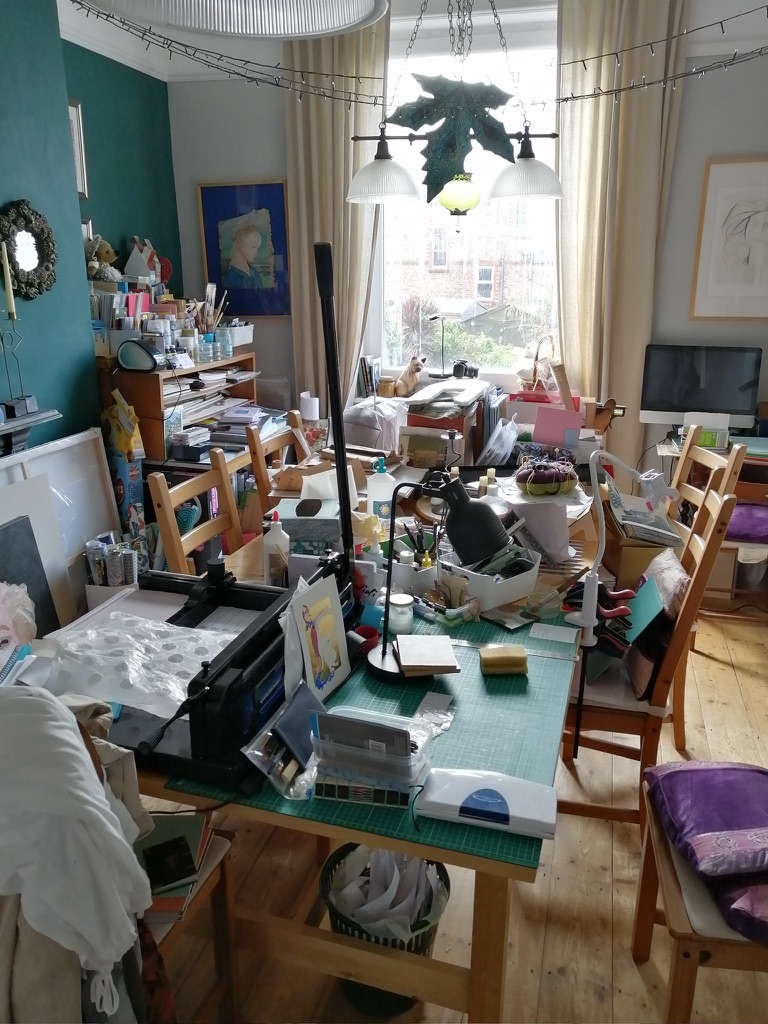For years, my basement has been more of a black hole than a functional space. Boxes stacked precariously, forgotten furniture gathering dust, and the general accumulation of “I’ll deal with this later” items have made it almost impossible to navigate.
And so, like many other crafters, my dining room table became my place of work. And as you can see, it had become, to the untrained eye, a space of utter devastation. I say untrained eye, because I knew where everything I needed was: on the right my work area; on the left the guillotine; further back – glues, paper storage, tools.

But it had got to a point where I had to draw the curtains on this part of the room, as I knew any visitors leaving would suffer from disorderliness hysteria.
There was also the issue of Christmas dinner. I needed to reclaim my table so I could fit 10 to 12 people around it in the next festive season. My god, and that was only six months away.
Enough was enough. It was time to reclaim both my dining room and hit my basement space—and not just for storage. My dream of having a dedicated bookbinding studio was finally going to come to life.
Past History
I should say that about ten years ago the room that I was now going to reclaim had been renovated – insulated, plaster boarded, electrocuted(!) – and so was a ‘complete’ room – unlike the rest of the basement which is ‘derelicte’ (Zoolander speak). It had been used by my daughter and partner when they were starting off with their mask making business, (Janus Masks) so it had been set up from them with table space and shelving etc. But since they moved out it has become a dumping ground for so long that it was going to take days to reclaim it.
So, I had to tackle the chaos. Like with so many jobs, in order to do or move one thing another has to be cleared…
Facing the Mess
Standing in the doorway, I was immediately overwhelmed. Where do you even start when your basement looks like a pawn brokers exploded? The answer, I discovered, is simply to start.
Be Ruthless – it’s Cathartic
I gave myself permission to be ruthless. If I hadn’t used it or thought about it in over a year, it went into the “donate” pile. The “donate” pile had a couple of elements – this could be to a) charity if it was good enough, or to b) the recycle centre. Anything broken or irreparably damaged went straight into the bin. By the end of the first day, I was basking in the number of piles I had amassed and my basement already felt a little tidier.
This process went on for a couple of days as there were a lot of things to wade through and playing Tetris became an essential part of the sorting/clearing process. This was no small feat. Some of the pieces of furniture I was shifting were heavy and awkward, and there were a few that I genuinely thought might never leave the basement. It was a workout, but seeing that room completely empty for the first time in years was a powerful motivator.
Cleaning As I Go
Dust and cobwebs had claimed every surface, and the floor was stained from years of neglect. I had my trusty bin bag and vacuum cleaner valiantly trailing behind me as I progressed around the room.
The cleaning process was also a chance to inspect the space more thoroughly. I noted areas where the walls needed wiping down and objects that could be reused would be addressed before moving on to the next stages.
It is a basement room, so ensuring there is enough light to work in was important. The weather was fine and I thought the ‘well’ in front of the window could do with a lick of paint. So climbing down a ladder, I painted the walls to reflect more light into the room.
Painting the Walls and Ceiling
Once the room was clean, it was time to transform the space visually. A fresh coat of paint does wonders for any room, and this basement was no exception.
Light being important, I used white to brighten the space and make it feel larger. The walls and the ceiling were painted white to reflect light. Even without furniture or decor, the room began to feel inviting and inspiring.
Preparing for Underfloor Heating
With the walls and ceiling looking fresh, it was time to get serious about making the space functional. Since bookbinding requires hours of sitting or standing, I wanted the room to be comfortable year-round. It is also important that there is no hint of damp where all my papers are stored. Underfloor heating was the perfect solution. So I spent inordinate amounts of time exploring various underfloor heating systems, insulations, you name it.
This was a big step in the process. I started by completely clearing the floor, making sure it was level, and laying insulation. Then came the electric heating mats, carefully arranged and secured. Installing the system required precision, but the idea of a cozy, warm studio kept me motivated.
Tiling the Floor
The next major step was tiling the floor. I chose durable, easy-to-clean tiles in a neutral tone to complement the walls and ceiling. Now I have no experience of tiling, but my talented daughter had enrolled in a tiling course and kindly took the lead with this major undertaking. This step took some patience—cutting and arranging tiles, applying adhesive, and grouting each section—but it was deeply satisfying to see the finished floor.
Not only does the tiled floor look beautiful, but it’s also practical for a workspace. Spilled glue or paint? No problem. A quick wipe, and it’s clean again.
Reflecting on the Transformation
Standing in my newly renovated basement, I can hardly believe it’s the same space. What was once a cluttered storage area is now on the verge of becoming my dream bookbinding studio. The room is clean, bright, and warm—ready for furniture, tools, and endless creativity.
Moving In
The next stage was perhaps the most enjoyable – setting up my studio:
- Installing a sturdy workbench and plenty of shelving for paper, tools, and materials.
- Adding good lighting for detailed work.
- Decorating the space to reflect my style and make it a place where I’ll love spending time.
The Importance of a Personal Workspace
Having a dedicated personal workspace is more than just a luxury—it’s a necessity for productivity, creativity, and mental well-being. Here are all the reasons why creating a space for your work is so important:
- Focus and Productivity
- A personal workspace minimises distractions, allowing you to concentrate on tasks without interruptions.
- It creates a clear boundary between work and leisure, helping to mentally prepare for focused work sessions.
- Encourages Creativity
- A space tailored to your needs and preferences can inspire creativity and innovation.
- Surrounding yourself with tools and materials specific to your craft keeps you immersed in your creative process.
- Organization and Efficiency
- A dedicated space allows for proper storage and organization of tools, materials, and projects.
- You save time by not having to set up or pack away your work every time you start or finish a task.
- Improves Mental Health
- Separating work from other areas of your home helps maintain a healthy work-life balance.
- A workspace that feels personal and comfortable can reduce stress and increase motivation.
- Supports Professional Growth
- A dedicated studio or workspace adds professionalism to your craft, whether it’s a hobby or a career.
- It gives you a sense of pride and ownership over your work environment, reinforcing your identity as a creator or professional.
- Customization and Comfort
- Personal workspaces can be customized to suit your unique workflow and ergonomic needs.
- You can design the space to include inspiring elements, such as artwork, plants, or lighting that suits your preferences.
- Encourages Consistency
- When you have a designated place to work, it’s easier to develop routines and habits that lead to consistent progress.
By creating a dedicated space I believe you’re not only reclaiming the space but also investing in yourself and your craft. This transformation is a step toward a more productive, fulfilling, and balanced work life.
Let me know what you think.
Oh and by the way, I did retrieve my dining table in time for Christmas Day.
